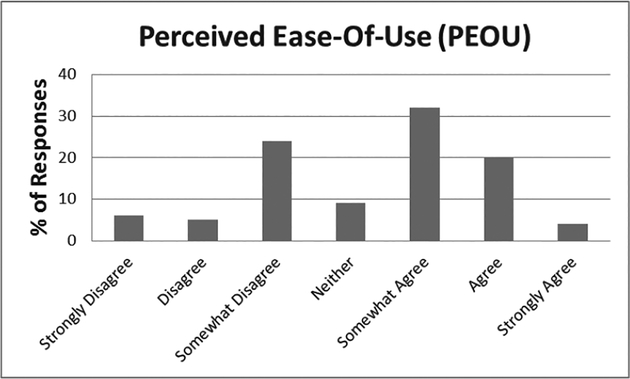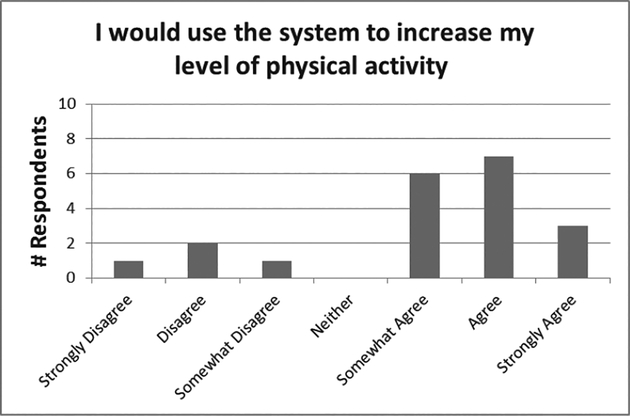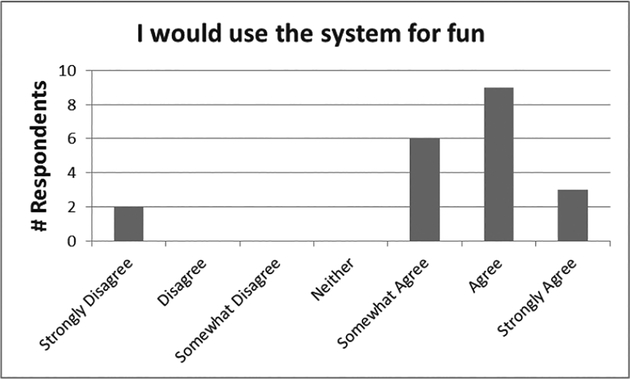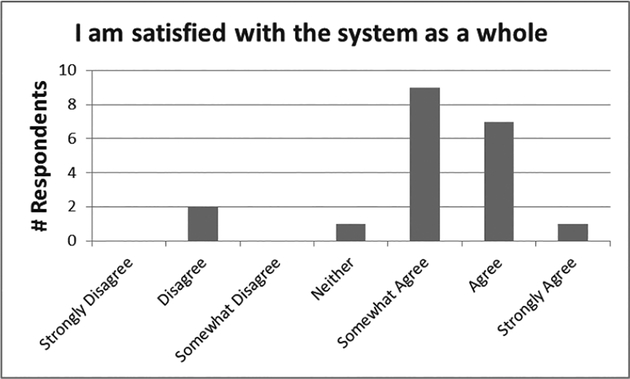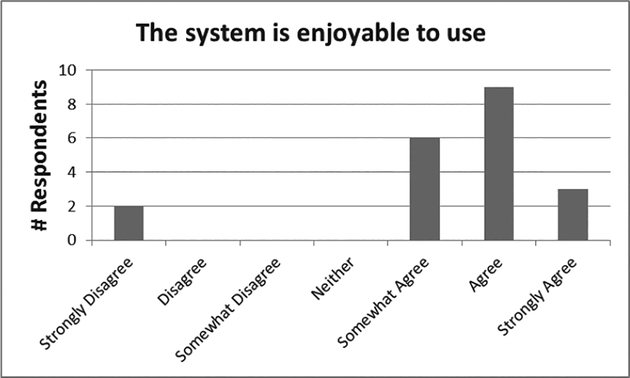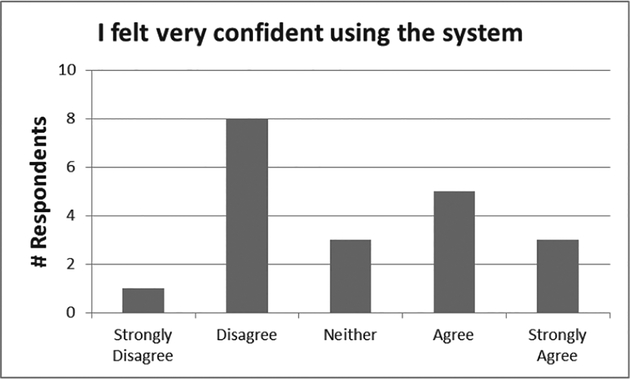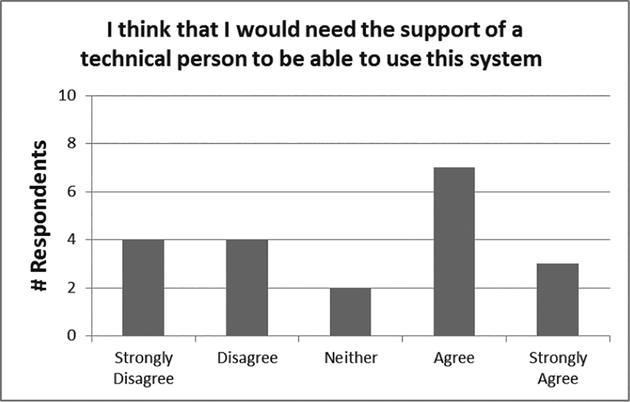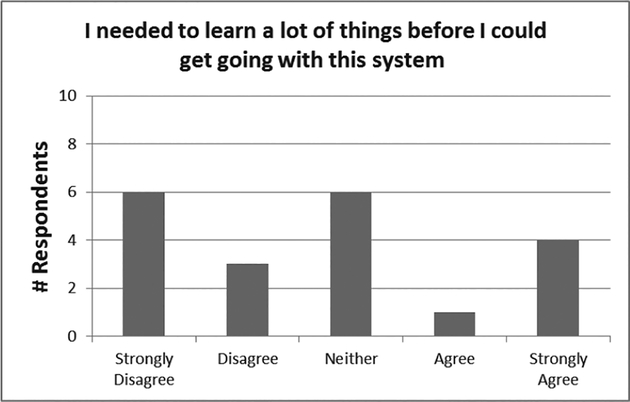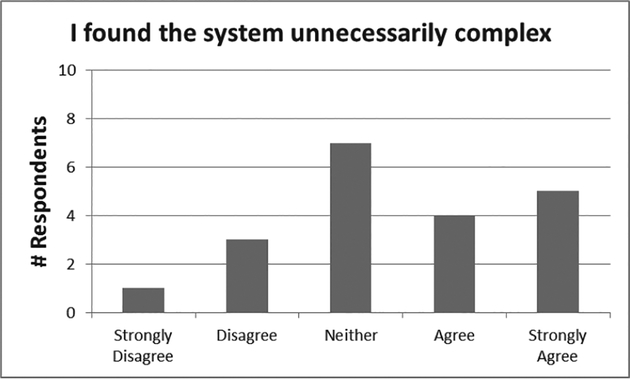Abstract
Purpose
Maintaining physical activity is a key component of successful aging and has benefits for both physical and cognitive functioning in the older adult population. One promising method for engaging in physical activity is through exergames, which are video games designed to promote exercise. Exergames have the potential to be used by a wide range of people, including older adults, in a variety of settings, such as at home, in community living environments, or senior centers. However, exergames have not been designed for older adults (e.g., with respect to their attitudes, needs). Thus, older adults may not adopt these systems if they perceive them as not useful or relevant to them.
Method
Twenty older adults (aged 60–79) interacted with two exergames, and were then interviewed about their perceptions of the system’s ease of use and usefulness, as well as their general attitudes towards the system.
Results
Participants identified the potential for exergames’ usefulness for various goals, such as to increase their physical activity. However, they also reported negative attitudes concerning the system, including perceiving barriers to system use. Overall, participants said they would use the system in the future and recommend it to other people at their age for improving health, despite these use challenges.
Conclusion
The older adults were open to adopting exergames, which could provide opportunities to increase physical activity. Given the participants’ overall positive perceptions of the usefulness of exergames, designers must address the perceived challenges of using these systems. Understanding barriers and facilitators for older adults’ use of exergames can guide design, training, and adoption of these systems.
Keywords: older adults, exergames, technology acceptance, system perceptions
Maintaining physical activity is a key component of successful aging. Regular physical activity has been shown to have a positive effect on sustaining and even improving the physical and cognitive well-being of older adults1. Increased physical activity, whether through exercise or rehabilitative therapy, led to improvements for older adults in cognitive and brain functioning2; gait and balance3; memory4; and stamina and muscle strength3. Additionally, older adults who engaged in moderate levels of physical activity had a reduced risk of falling, lessened symptoms of depression and anxiety, and lived independently longer2.
However, the National Center for Statistics reported that 54% of older adults aged 65–74 and 68% of older adults over the age of 75 do not meet the minimum levels of physical activity as recommended by the U.S. Federal Physical Activity guidelines5,6. Numerous barriers may prevent this population from exercising as recommended, including: not knowing how to initiate an exercise regimen7; lack of access to fitness instruction; and the inability to travel to public activity centers due to a physical limitation, poor weather conditions, or inefficient public transportation8. Inadequate physical activity can potentially have long-term consequences, such as reducing a person’s ability to successfully age-in-place. Aging-in-place is defined as the ability for adults to remain in their own homes and communities while still being able to successfully perform the necessary activities of daily living as they age into older adulthood9. Aging-in-place is a priority for older adults10.
In-home interactive technologies are a viable approach to support older adults in beginning and maintaining physical exercise regimens. Exertion games (exergames), or interactive gesture-based video games, allow players to engage in physical, cognitive, and exercise-based activities, guiding users through competitive sports, stretching and therapeutic movements, or brain puzzles11. Users can play with on-screen avatars or peers in multiplayer mode. These sensor-based systems operate by monitoring an individual’s movements and responses to an on-screen avatar, and providing feedback (e.g., error icons, suggested re-alignments, auditory cues) as to whether movements or actions are completed correctly. Game users progress through levels of intensity and complete courses similar to a fitness class without having to physically go to a gym. Easily obtainable platforms for exergames, such as the Nintendo Wii or Microsoft Kinect, present an opportunity to alleviate some of the barriers that older adults face when attempting to exercise or begin a physical therapy regimen.
Older adults could benefit from exergames’ physical, cognitive, and exercise-based activities, such as through the application of wellness-focused games targeted to their needs and interests12. Researchers have studied the use of in-home exergames as an intervention for improving physical and mental well-being5,11,13–19 and as a new avenue for older adults’ participation in leisure activities20. Most typically, these games have been used for social interaction among two or more players21. Exergames have also been applied to therapeutic and rehabilitation scenarios for various users including older adults, with outcomes such as improved gait and balance as well as better mental-health-related quality of life11,13–21. Exergames increased the level of physical activity of otherwise-sedentary individuals21. Additionally, exergames provided considerable cognitive and sociocultural benefits for older adults, such as improved affect, attention, memory, reasoning, self-esteem, and socialization among peers and across generations8,22–25.
Despite the breadth of potential benefits of exer-games, older adults may not adopt the systems if they do not perceive them to be useful or if they perceive significant usability challenges. These attitudes drive an individual’s acceptance of a technology, which is the precursor of adoption. Technology acceptance has been characterized in the Technology Acceptance Model and its extensions26–28. Components of technology acceptance include attitudinal acceptance, intentional acceptance, and behavioral acceptance27,29. One primary factor that influences technology acceptance is perceived ease of use (PEOU), which is “the degree to which a person believes that using a particular system would be free of effort”26. A second influential factor is perceived usefulness (PU), which is “the degree to which a person believes that using a particular system would enhance his or her job performance”26. In a review of studies on studies focusing on usability of exergames for older adults, PEOU and PU were identified as primary explanatory measures30. Other factors contributing to technology acceptance include user confidence, perceptions of technology complexity, and overall enjoyment of the system. Evaluating these metrics is often beneficial to understanding the reasoning for technology adoption and/or abandonment beyond solely investigating the usability of a technology.
Although much is known about the potential benefits and challenges faced by older adults when interacting with exergames, there has been minimal in-depth qualitative research on the attitudes and perceptions of this user population concerning the acceptance and use of these games as a viable means to physical activity. In the recent review of studies investigating usability and acceptance of exergames by older adults, some studies included interviews to gather in-depth acceptance information, but many of these studies were focused on special populations such as stroke victims and war veterans30–32. Additional studies have used interviews, but have focused more on assessing attitudes towards specific exergames as opposed to evaluating more general reasons for long-term adoption of exergame systems as whole33. Information such as the reasons underlying PEOU, PU, and intentions to use exergame systems through both standard measures and in-depth interviews could provide insights into how older adults perceive these games, which can then inform how to facilitate their adoption of exergames.
To understand older adults’ perceptions and attitudes towards using exergames, we conducted a mixed-methods study using quantitative and qualitative measures. We assessed participants’ perceptions of ease of use, usefulness, and other factors that predict technology acceptance, such as perceived complexity and enjoyment. We also assessed participants’ intentions to use exergames. General guidelines for studies using qualitative research of this types are to include minimum 20 participants34–35.
The Microsoft Xbox 360® with Kinect® system was chosen to focus on gesture-based performance in a generally healthy population. Many research studies examining the use of exergames have focused primarily on stroke and injury rehabilitation, using systems such as the Nintendo Wii® with balance board30. Few studies have examined the utility of gesture-based systems for use beyond therapy and rehabilitation, such as leisure and physical activity promotion. Existing gaming platforms and games were researched thoroughly for their relevance to this goal. Researchers contacted current platform and gaming distributors such as Microsoft and GameStop in this assessment. Although there are more current systems and generations of the Xbox 360, such as the Microsoft Xbox One®, researchers were unable to identify appropriate games that met the needs of older adults comparable to Your Shape Fitness Evolved 2012 and Body and Brain Connection. For the reasons of focusing on gesture-based performance for assessing the potential of exergames for improving older adults’ physical activity, we determined the Kinect system was the most appropriate for this study. For these reasons, we also believe that study findings when using this platform will generalize to fundamental user experience and attitudes for newer and emerging gesture-based products and systems.
This study aimed to identify key barriers and facilitators to exergame use by addressing the following research questions: What are older adults’ perceptions of an exergames system? What factors are driving these perceptions? Additionally, we discuss how these findings can inform future design guidelines of exergames systems for use by the older adult population. Improving design guidelines can ultimately increase adoption of these systems that have the potential to improve physical activity and successful aging. Lastly, we identify the needs for additional support for users who are newer to using exergame systems.
METHOD
Participants
Participants were recruited from the Human Factors and Aging Laboratory Participant Registry at the Georgia Institute of Technology. All participants were screened for visual, hearing, or motor disabilities that might prevent them from performing the physical movements needed to participate in the study. Screening also ensured participants had no previous experience with the exergame system used in this study.
Twenty-three older adults participated but three were excluded from analyses due to equipment issues experienced while using the exergame system: the Kinect system did not sense the lower body of two of the participants, and the video camera shut off in the middle of the session for the third participant, leading to incomplete data which could not be coded. The 20 participants were community dwelling older adults (aged 60–79, 10 male, M = 70, SD = 4.79). Seven of the participants were African American, 1 participant was Asian and the remaining identified as Caucasian. The majority of the participants were well-educated, with 80% having some college training. Participants rated their general health as “good” to “very good” on a scale of 1=poor, 3=good, 5=excellent (M = 3.6, SD = 0.75).
Participants had a general technology breadth score mean of 23.85 (SD = 5.93), which indicates moderate technology use36. In terms of the technology of video games, 50% of participants previously had used a console video game system. Most participants (70%) had experience with PC-based or mobile video games (e.g. Tetris, Candy Crush, Solitaire).
Materials
Exergame system
The platform for this study was the Microsoft Xbox 360® with Kinect® system. Participants interacted with two programs: Body and Brain Connection37 and Your Shape Fitness Evolved38. These programs were chosen because they include components of light physical activity. The Body and Brain Connection program incorporates both physical and mental exercises, while the Your Shape Fitness Evolved program is a beginners’ Tai Chi routine.
Script for guiding exergame system use
To ensure consistency across participants, the researchers followed a script with tasks, instructions, and hints. Hints were developed for every task but provided to participants only when errors were made.
Background questionnaires
The Health and Demographics Questionnaires assessed participants’ overall health and collected background information including age, gender, race, and education as well as any vision, hearing, or mobility limitations39. The Technology Experience Questionnaire assessed use and familiarity with various technologies36. An adapted Video Game Experience questionnaire40 assessed level of familiarity with video games and the participants’ gaming habits.
Exergame acceptance questionnaires
Two questionnaires adapted Technology Acceptance Model scales of PEOU27 and PU26. The first assessed perceived ease of use (PEOU) using 5 items: (1) I found the system easy to use, (2) I found the system flexible for me to interact with, (3) It was easy for me to become skillful at using the system, (4) I found it easy to get the system to do what I wanted it to do, and (5) Learning to operate the system was easy for me. These items were assessed on a 7-point Likert scale, ranging from 1-strongly disagree to 7-strongly agree.
The second questionnaire used the same scale to assess perceived usefulness (PU) with five items: (1) My interaction with the system was clear and understandable, (2) I would find the system useful in my daily life, (3) Using the system in my daily life would make me more physically active, (4) Using the system would make it easier for me to be physically active, and (5) Using the system would improve my daily life.
A third questionnaire assessed overall experience with the exergame system and included six items: (1) I found the system unnecessarily complex, (2) I think that I would need the support of a technical person to be able to use this system, (3) I found the various functions in this system were well integrated, (4) I thought there was too much inconsistency in this system, (5) I felt very confident using the system, and (6) I needed to learn a lot of things before I could get going with this system. These items were assessed on a 5-point Likert scale, ranging from 1-strongly disagree to 5-strongly disagree.
Additional questionnaires
Program-specific satisfaction questionnaires were administered for both programs (Body and Brain Connection, Your Shape Fitness Evolved) to assess participant satisfaction with the two programs. Participants also completed a questionnaire adapted from the System Usability Scale41 that measured the usability of the system. The results of these questionnaires are not presented in this paper due to issues of reliability with the scale adaptation.
Semi-structured interview script
Participants were interviewed to assess their attitudes and opinions about each program and their experience with the overall system. They were asked to explain what they liked and did not like about a program. Additionally, they were asked if they would have benefited from additional help or instruction throughout the program and how they would have liked this help presented.
Procedure
The assessment took place at the Georgia Tech Aware Home, a research facility that simulates an authentic home environment (http://www.awarehome.gatech.edu/). Prior to arriving at the Aware Home, participants were mailed and asked to complete the Health and Demographic Questionnaire, Technology Experience Questionnaire, and Video Game Experience Questionnaire. Participants gave consent to participate in the study in accordance with the Georgia Institute of Technology’s Institutional Review Board policies and practices. Two video cameras recorded the participants during their interaction with the exergame system to accurately code participants’ actions. One camera was placed in front of the participant; the other camera was placed behind the participant. Participants then began one of two programs, Body and Brain Connection37 or Your Shape Fitness Evolved38.
Participants were assessed individually and were assigned a program order so that 50% completed Body and Brain Connection first. Tasks included turning on the Xbox system, loading the disc, starting the program, playing the program, reviewing the results of the program, ejecting the disc, and turning off the Xbox system Researchers provided hints related to the task being completed when initial errors were made. Initial errors, hints, and error corrections were coded for analysis. After completing the first program, participants were given program-specific satisfaction questionnaires and were interviewed about the program. Participants then followed the same procedure for the second program. After completing both exergame programs, participants were given exergame perception questionnaires concerning overall system measures and were asked about their attitudes and opinions in regard to the overall system. All interview responses were audio recorded for later transcription.
RESULTS
Portions of the exergame perception questionnaire data were previously reported42, including the range of ratings for Perceived Ease of Use and Perceived Usefulness of these systems. Usability challenges were also reported. In this paper, we present additional qualitative data to enhance understanding of these ratings as well as additional measures that were not previously reported.
Perceived Ease of Use (PEOU)
PEOU is an index of a person’s perception of how much or how little effort is required to use a system. The majority of participants’ responses indicated that they perceived exergames to be moderately easy to use (mode = somewhat agree), although a third of the responses indicated that they ‘somewhat’ to ‘strongly’ disagreed with the ease of use statements (Figure 1). These ratings were likely influenced by the challenges and barriers participants encountered in using the system. There was a range of responses, which illustrate the value of qualitative data to understand the reasons underlying these ratings.
Figure 1.
Percentage of participants’ responses to the five PEOU questions on a scale of strongly disagree to strongly agree
The interview data provide insights into the quantitative ratings. We used a thematic analysis approach to identify themes that represented the reasons driving participants’ attitudes43. Participants (15 of the 20) reported a variety of reasons as to why people may not want to or be able to use the exergame system. Reasons were related to the person (e.g., four respondents mentioned barriers related to physical limitations), the system (e.g., two respondents mentioned poor instructions), as well as the person-system interaction (e.g., two respondents each mentioned effort, frustration, and intimidation). For example, one participant mentioned that older adults might be “physically or mentally unable to [use the system]”. Another participant mentioned that the system was “unnecessarily complex or fast-paced”. Demonstrating frustration with the system, one participant would not recommend the system to others because they “would not be willing to invest the time or the feeling of ignorance into going back and trying to figure out what to do. They have lives”. Overall, these findings suggest that PEOU may be improved by implementing design changes to improve usability for older adults, as well as providing additional instruction/training.
Perceived Usefulness (PU)
PU in this context indicates perceptions of how much using a system will enhance engagement in physical activity. The majority of participants’ responses were generally positive, rating the exergame system as having moderate-to-high PU (mode = agree; Figure 2). These ratings indicate that participants believed the system would be useful for achieving various goals, such as increasing physical activity.
Figure 2.
Percentage of participants’ responses to the five PU questions on a scale of strongly disagree to strongly agree.
We examined the interview data to understand the reasons driving these positive perceptions. When asked about potential benefits of using an exergame system, almost all participants thought using the system could increase activity and reduce barriers to being active. One participant stated that “[the system] would be helpful for senior citizens to get more active and use their brains more and use the workout more”. Physical activity was identified by 17 of the 20 participants as the main benefit of using the system.
In addition to physical exercise, 8 of the 17 participants identified mental exercise as a key benefit. For example, one participant stated, “[the system]’s something that would keep me active and keep me thinking”. Six participants noted that exergames could lead to improvements in general health (e.g., weight, flexibility). Other perceived positive cognitive outcomes of using the system included challenging themselves and learning, each of which was mentioned by two participants. Ultimately, the depth and breadth of participants’ identification of multiple avenues for exergames’ usefulness supports the potential of exergames for positive physical, mental, and cognitive outcomes.
Intentions to Use or Recommend
Most participants said they would use the system in the future (n=15) and would recommend it to others (n=16). The majority of participants indicated they would use the system to increase their levels of physical activity (Figure 3). Additionally, when participants were asked whether they would use the system for fun, the majority responded positively (n=18; Figure 4).
Figure 3.
Participants’ responses to the statement “I would use the system to increase my level of physical activity” on a scale of strongly disagree to strongly agree
Figure 4.
Participants’ responses to the statement “I would use the system for fun” on a scale of strongly disagree to strongly agree
The most common reason participants reportedly would use the system was for physical activity, a statement also supported by questionnaire data (Figure 3). Five of the twenty participants said they would use the system in place of other exercise (e.g., two participants would prefer to exercise at home instead of having to go elsewhere to exercise). Two participants noted that the system could provide a workaround for current barriers to exercise (e.g., poor weather). One participant stated that being able to exercise in private using the system would reduce embarrassment associated with working out in front of other people. Other reasons for using the system that were mentioned by at least two participants included perceptions that the system would be: a positive new experience, fun, helpful, cognitively stimulating, and less physically demanding in the face of age-related motor changes. For example, one participant stated that, “[The system]’s different, it’s new, it’s something that would keep me active and keep me thinking”. Interestingly, three participants said physical exercise was the reason they did not intend to use the system; they would rather participate in alternative exercise activities (e.g., outdoor activities) over using the system.
The main reason participants intended to recommend the system to other older adults was similar to why they would use it themselves; namely, for cognitive and physical benefits. Of the 15 participants who identified these benefits, 7 mentioned both cognitive and physical benefits, 5 mentioned cognitive benefits only, 2 mentioned physical benefits only, and 1 mentioned general benefits. For example, one participant stated that, “[the system] would be helpful for senior citizens to get more active and use their brains more and workout more”. Other reasons that were mentioned by at least two participants included perceptions that the system would be: social, fun, helpful, involve learning, and less physically demanding in the face of age-related motor changes. However, 2 participants noted that older adults who have physical limitations (e.g., wheelchair users) may not be able to use some programs, so they would not recommend the system for them. Additionally, five participants mentioned that potential frustration using the system would limit their recommendations.
Overall, participants reported that they would use the system themselves and recommend the system to others, which corresponds to their overall high ratings of PU. The main perceived advantages of using the system were physical and cognitive benefits, as noted by a high number of participants. Although participants generated multiple perceived benefits to the system, some participants noted challenges (e.g., alternative physical activity preferences, frustration using the system). Nevertheless, the majority of participants rated PU as high.
General System Perceptions
When participants were asked about their attitudes towards the system after interacting with two programs, they were satisfied with the exergame system overall (Figure 5). Similarly, the vast majority of participants enjoyed using the exergame system (Figure 6). Both of these measures demonstrated positive attitudes towards the system, with very few participants in disagreement. When asked if they could change anything about the system, half of the participants said they would not change anything. Of the 10 participants who would change something about the system, 5 identified the need for clearer instructions.
Figure 5.
Participants’ responses to the statement “I am satisfied with the system as a whole” on a scale of strongly disagree to strongly agree
Figure 6.
Participants’ responses to the statement “The system is enjoyable to use” on a scale of strongly disagree to strongly agree
Despite these generally positive attitudes towards the system, participants varied in confidence about their abilities to actually use the system (Figure 7). The modal response to the statement of “I felt very confident using the system” was ‘Disagree’. Participants’ opinions varied in: (a) whether they thought they would need technical support to successfully use the system, with the modal response being that they agreed they would need this support (Figure 8); and (b) whether they thought they needed to learn a lot prior to beginning use the system (Figure 9). Perhaps related to their range of expressed confidence and desired support, participants also varied in their judgments of system over-complexity, with more participants viewing the system as unnecessarily complex than not (Figure 10).
Figure 7.
Participants’ responses to the statement “I felt very confident using the system” on a scale of strongly disagree to strongly agree
Figure 8.
Participants’ responses to the statement “I think that I would need the support of a technical person to be able to use this system” on a scale of strongly disagree to strongly agree
Figure 9.
Participants’ responses to the statement “I needed to learn a lot of things before I could get going with this system” on a scale of strongly disagree to strongly agree
Figure 10.
Participants’ responses to the statement “I found the system unnecessarily complex” on a scale of strongly disagree to strongly agree
In summary, older adults were generally positive in terms of perceptions of exergames’ usefulness (e.g., physical and cognitive benefits) as well as their overall enjoyment of interacting with the system. There were many underlying reasons driving these perceptions, mostly focused on how the exergame system could improve engagement in a variety of activities from the home. However, the participants varied in their perceptions of how easy the exergame system was to use. General perceptions about their ability to use the system (e.g., technical support, learning needs, complexity) were very mixed, indicating that more work is needed to increase older adults’ confidence in being able to use exergames on their own.
DISCUSSION
Exergames are a promising method for enabling older adults to engage in physical activity, which is a key component of successful aging1,9. Exergames have been used as a supplement for, or as a primary source of, physical activity and leisure engagement for older adults10,13–21. These systems can be employed in a range of settings (e.g., nursing facilities, assisted living environments, private homes, physical therapy offices) to allow access, social support, and feedback for multiple individuals to improve their physical activity. However, the majority of exergame programs were not designed considering the older adult population. If exergame programs do not adequately support the goals, capabilities, and preferences of older adults they will likely not adopt them as a physical activity intervention, even if the programs are considered useful.
The goal of this study was to understand how older adults perceive the ease of use and usefulness of gesture-based systems, as well as their general attitudes towards the system, all of which can affect their adoption of that technology27,29. Future work should assess long-term behavioral acceptance and technology use.
This study used measures from known technology acceptance models; however, unlike other studies, we supplemented these measures with additional questionnaires (e.g., perceived complexity) as well as with qualitative data from interviews to provide insights into the basis for their technology acceptance ratings. These data can guide design for older users for next-generation designs, supplementary instructions, and system support aids.
Participants in this study recognized and appreciated the potential of exergames for increasing physical activity, among a wide range of other benefits. Even though participants faced performance challenges using the system and only perceived it as moderately easy to use, they overwhelmingly intended to both use the system and recommend it to other older adults. Participants were generally optimistic about the exergame system’s usefulness. They identified a range of benefits of using the system. Physical activity_ although a frequently identified benefit_was only one aspect of the usefulness of exergame systems. For example, these programs were viewed as fun, helpful, social, cognitively stimulating to use, and good for improving general health.
The present findings provide information about the potential barriers to use by older-related to their self-confidence and concerns about difficulties using the exergames. Family members, healthcare professionals, exercise instructors, and staff in senior communities, among others, can use this information to introduce exergames to older adults. For example, if an activities director at a senior living facility looking for ways to increase residents’ physical activity level could use exergames and specifically highlight its facilitators, such as it being a good exercise option on a rainy day and a good way to promote socialization. Additionally, recognizing that barriers to exergames include confusion and intimidation, staff members could ensure that someone was present to assist with using these games. Ultimately, the support network around an older adult can leverage the factors influencing acceptance of exergames to improve adoption.
The main reason participants did not intend to use the system was that they preferred to complete alternative physical activities (e.g., walking, biking). However, perceptual, motor, and cognitive changes as people age restricts some older adults’ ability to perform these other activities. Exergames could be used to supplement alternative activities and provide increasing support over time.
In their current design, Kinect-based exergames were not perceived by older adults as easy to use, despite other studies finding positive perceptions of ease of use with PEOU. The majority of the participants did not feel confident using the system, despite having moderate to high positive attitudes about the usefulness of exergame systems. Furthermore, a quarter of the participants stated that frustration using the system would limit their recommendations for others to use the system, thus suggesting a need to address system usability as a direct contributing factor to intention to adopt these systems. Addressing these perceptions and attitudes through system support may improve user confidence and reduce frustration. Such support materials may also help to reduce the performance errors that we documented42. Improving usability of the system through training or system redesign could increase perceived ease of use, which in turn could increase initial and continued adoption of the system.
A future direction for the design and development of exergames is enabling usability for individuals with a range of motor, cognitive, and perceptual capabilities and limitations (e.g., allowing seated game play). This could be accomplished by utilizing principles of universal and inclusive design (designing considering the abilities and potential limitations of all users). The participants in this study had self-assessed good to very good health overall, and were screened for visual, hearing, or motor disabilities that might prevent them from performing the physical movements needed to participate in the study. The general population of older adults includes a greater range of health and wellness (e.g., wheelchair users), which may reduce the capability of some to use the current system (e.g., motions requiring full body movements). By applying universal design principles such as better perceptible information, higher tolerance for error, and lower physical effort44, exergame systems would be accessible to a wider range of users.
Understanding the challenges experienced during older adults’ interaction with exergame systems also suggests a need for the design of training and support materials to aid in the use of these systems. Future work could include improving the design of system support, such as having in-game help tutorials, reducing the complexity of on-screen instructions, and designing navigation controls that consider the reduced dexterity and motor control of older adults and other users with impairments. Additionally, supplementary materials that accompanied the system could be beneficial to older adults for initial learning of the system and as a reference guide for continued use. In particular, there are opportunities for addressing gesture performance needs. Training materials such as a quick-start user guide could aid users in understanding gesture controls and provide helpful tips in beginning and navigating through a game. This solution could reduce frustration and complexity, and enhance potential benefits. By utilizing principles of universal and inclusive design and providing adequate training guides, researchers and designers can improve the ease-of-use of exergame systems, thus making them more enjoyable for the end user and more likely to be used45. Given the range of corroborating information from multiple sources (e.g., usability assessment, questionnaires, interviews), it is clear that exergames have the potential to support older adults with a range of activities (e.g., physical, mental), which can in turn lead to successful aging.
Acknowledgements
This research was supported in part by a grant from the National Institutes of Health (National Institute on Aging) Grant P01 AG17211 under the auspices of the Center for Research and Education on Aging and Technology Enhancement (CREATE; www.create-center.org). We also would like to acknowledge the National Institute on Disability and Rehabilitation Research (Department of Education) Grant H133E130037 under the auspices of the Rehabilitation and Engineering Research Center on Technologies to Support Successful Aging with Disability (TechSAge; www.techsage.gatech.edu). Portions of these data were presented at the Human Aspects of IT for the Aged Population Conference (Los Angeles, August 2015) and appear in the proceedings of that conference (Harrington et al., 2015).
References
- 1.Center for Disease Control and Prevention. Physical Activity and Health: A Report from the Surgeon General, 1999. National Center for Chronic Disease Prevention and Health Promotion, Division of Nutrition and Physical Activity. Retrieved November 15, 2015 from http://www.cdc.gov/nccdphp/sgr/olderad.htm [Google Scholar]
- 2.Bherer L, Erickson KI, Liu-Ambrose T. A review of the effects of physical activity and exercise on cognitive and brain functions in older adults. Journal of Aging Research 2013;2013(9):1–8; 10.1155/2013/657508 [DOI] [PMC free article] [PubMed] [Google Scholar]
- 3.Sherrington C, Tiedemann A, Fairhall N, Close JCT, Lord SR. Exercise to prevent falls in older adults: An updated meta-analysis and best practice recommendations. New South Wales public health bulletin 2011;22(4):78–83; 10.1071/NB10056 [DOI] [PubMed] [Google Scholar]
- 4.Lautenschlager NT, Cox KL, Flicker L, Foster JK, van Bockxmeer FM, Xiao J, Greenop KR, Almeida OP. Effect of physical activity on cognitive function in older adults at risk for Alzheimer disease: a randomized trial. Jama 2009;300(9):1027–1037; 10.1001/jama.300.9.1027 [DOI] [PubMed] [Google Scholar]
- 5.Pigford T. Feasibility and Benefit of Using the Nintendo Wii Fit for Balance Rehabilitation in an Elderly Patient Experiencing Recurrent Falls. Journal of Student Physical Therapy Research 2010;2(1):12–20 [Google Scholar]
- 6.Schiller J, Lucas J, Peregoy J. Summary health statistics for U.S. adults: National Health Interview Survey 2011, 2012. National Center for Health Statistics. Vital and Health Statistics, 10(256) [PubMed] [Google Scholar]
- 7.Klompstra L, Jaarsma T, Strömberg A. Exergaming to increase the exercise capacity and daily physical activity in heart failure patients: a pilot study. BMC Geriatrics 2014;14(1):119–127; 10.1186/1471-2318-14-119 [DOI] [PMC free article] [PubMed] [Google Scholar]
- 8.Velazquez A, Martinez-Garcia A, Favela J, Hernandez A, Ochoa S. Design of exergames with the collaborative participation of older adults. Proceedings of the 2013 IEEE 17th International Conference on Com puter Supported Cooperative Work in Design Whistler, Canada 2013;pp 521–526; 10.1109/CSCWD.2013.6581016 [DOI] [Google Scholar]
- 9.Bayer AH, Harper L. Fixing to Stay: A National Survey on Housing and Home Modification Issues—Executive Summary. American Association of Retired Persons; 2000; Retrieved from: https://assets.aarp.org/rgcenter/il/home_mod.pdf [Google Scholar]
- 10.Gitlin LN N Conducting research on home environments: Lessons learned and new directions. The Gerontologist 2003;43(5):628–637; 10.1093/geront/43.5.628 [DOI] [PubMed] [Google Scholar]
- 11.Schoene D, Lord SR, Delbaere K, Severino C, Davies TA, Smith S. A Randomized Controlled Pilot Study of Home-Based Step Training in Older People Using Videogame Technology. PLoS ONE 2013;8(3):e57734; 10.1371/journal.pone.0057734 [DOI] [PMC free article] [PubMed] [Google Scholar]
- 12.Entertainment Software Association of Canada. Essential Facts about the Canadian Computer and Video Game Industry, 2009. Retrieved November 23, 2015 from http://www.theesa.ca/documents/Essen-tialFacts2009EN.pdf.
- 13.Nawaz A, Waerstad M, Omholt K, Helbostad JL, Vereijken B, Skjaeret N, Kristiansen L. Designing simplified exergame for muscle and balance training in seniors: A concept of out in nature. Proceedings of the 8th International Conference on Pervasive Computing Technologies for Healthcare. ICST (Institute for Computer Sciences, Social-Informatics and Telecommunications Engineering), Oldenburg, Germany, 2014 May 20;pp 309–312; 10.4108/icst.pervasivehealth.2014.255269 [DOI] [Google Scholar]
- 14.Rosenberg D, Depp CA, Vahia IV, Reichstadt J, Palmer BW, Kerr J, Norman G, Jeste DV. Exergames for subsyndromal depression in older adults: A pilot study of a novel intervention. American Journal of Geriatric Psychiatry 2010;18(3):221–226; 10.1097/JGP.0b013e3181c534b [DOI] [PMC free article] [PubMed] [Google Scholar]
- 15.Bieryla KA, Dold NM. Feasibility of Wii Fit training to improve clinical measures of balance in older adults. Clinical Interventions in Aging 2013;8(1):775–781; 10.2147/CIA.S46164 [DOI] [PMC free article] [PubMed] [Google Scholar]
- 16.Araullo J, Potter LE. Promoting physical activity in seniors: Future opportunities with emerging technologies. Proceedings of the 2016 ACM SIGMIS Conference on Computers and People Research 2016;57–64; 10.1145/2890602.2890616 [DOI] [Google Scholar]
- 17.Bird ML, Clark B, Millar J, Whetton S, & Smith S. Exposure to “Exergames” Increases Older Adults’ Perception of the usefulness of technology for improving health and physical activity: A pilot study. JMIR Serious Games 2015. Jul-Dec;3(2); 10.2196/games.4275 [DOI] [PMC free article] [PubMed] [Google Scholar]
- 18.Hasselmann V, Oesch P, Fernandez-Luque L, & Bachmann S. Are exergames promoting mobility an attractive alternative to conventional selfregulated exercises for elderly people in a rehabilitation setting? Study protocol of a randomized controlled trial. BMC Geriatrics 2015;15(1):108; 10.1186/s12877-015-0106-0 [DOI] [PMC free article] [PubMed] [Google Scholar]
- 19.Mocanu I, Marian C, Rusu L. Arba R. A Kinect based adaptive exergame. Intelligent Computer Communication and Processing (ICCP), 2016 IEEE 12th International Conference 2016;pp 117–124; 10.1109/ICCP.2016.7737132 [DOI] [Google Scholar]
- 20.McLaughlin A, Gandy M, Allaire J, Whitlock L. Putting fun into video games for older adults. Ergonomics in Design: The Quarterly of Human Factors Applications 2012;20(2):13–22; 10.1177/1064804611435654 [DOI] [Google Scholar]
- 21.Lieberman DA, Chamberlin B, Medina E, Franklin BA, Sanner BM, Vafiadis DK. The power of play: innovations in getting active summit 2011 a science panel proceedings report from the American Heart Association. Circulation. 2011. May 31;123(21):2507–2516; 10.1161/CIR.0b013e318219661d [DOI] [PubMed] [Google Scholar]
- 22.Basak C, Boot WR, Voss MW, Kramer AF. Can training in a real-time strategy videogame attenuate cognitive decline in older adults? Psychology and Aging 2008;23(4):765–777; 10.1037/a0013494 [DOI] [PMC free article] [PubMed] [Google Scholar]
- 23.Green CS, Bavelier D. Effect of action video games on the spatial distribution of visuospatial attention. Journal of Experimental Psychology: Human Perception and Performance 2006;32(6):1465–1478; 10.1037/0096-1523.32.6.1465 [DOI] [PMC free article] [PubMed] [Google Scholar]
- 24.Jung Y, Li KJ, Janissa NS, Gladys WLC, Lee KM. Games for a better life: effects of playing Wii games on the well-being of seniors in a long-term care facility. Proceedings of the Sixth Australasian Conference on Interactive Entertainment ACM, Australia 2009;5–10; 10.1145/1746050.1746055 [DOI] [Google Scholar]
- 25.Maillot P, Perrot A, Hartley A. Effects of interactive physical-activity video-game training on physical and cognitive function in older adults. Psychology and Aging 2012;27(3):589–600; 10.1037/a0026268 [DOI] [PubMed] [Google Scholar]
- 26.Davis FD. Perceived usefulness, perceived ease of use, and user acceptance of information technology. MIS Quarterly 1989;13(3):319–40; 10.2307/249008 [DOI] [Google Scholar]
- 27.Davis FD, Bagozzi RP, Warshaw PR. User acceptance of computer technology: a comparison of two theoretical models. Management Science 1989;35(8):982–1003; 10.1287/mnsc.35.8.982 [DOI] [Google Scholar]
- 28.Venkatesh V, Bala H. Technology acceptance model 3 and a research agenda on interventions. Decision Sciences 2008;39(2):273–315; 10.1111/j.1540-5915.2008.00192.x [DOI] [Google Scholar]
- 29.Van Ittersum KO, Rogers WA, Capar M, Caine KE, O’Brien MA, Parsons LJ, Fisk AD. Understanding technology acceptance: Phase 1–literature review and qualitative model development Technical Report HFA-TR-0602. Atlanta, GA: Georgia Institute of Technology, School of Psychology, Human Factors and Aging Laboratory; 2006 [Google Scholar]
- 30.Nawaz A, Skjæret N, Helbostad JL, Vereijken B, Boulton E, Svanaes D. Usability and acceptability of balance exergames in older adults: A scoping review. Health informatics journal 2016; 22(4):911–931; 10.1177/1460458215598638 [DOI] [PubMed] [Google Scholar]
- 31.Chiang I-T. Old dogs can learn new tricks: exploring effective strategies to facilitate somatosensory video games for institutionalized older veterans In: Chang M, Hwang W-Y, Chen M-P, et al. (eds) Edutainment technologies. Educational games and virtual reality/augmented reality applications 2014. Berlin: Springer, p.190; 10.1007/978-3-642-23456-9_34 [DOI] [Google Scholar]
- 32.Celinder D, Peoples H. Stroke patients’ experiences with Wii Sports® during inpatient rehabilitation. Scandinavian Journal of Occupational Therapy 2012;19(5): 457–463; 10.3109/11038128.2012.655307 [DOI] [PubMed] [Google Scholar]
- 33.Nawaz A, Skjæret N, Ystmark K, Helbostad JL, Vereijken B, & Svanæs D. Assessing seniors’ user experience (UX) of exergames for balance training. In Proceedings of the 8th Nordic conference on human-computer interaction: Fun, fast, foundational 2014;578–87; 10.1145/2639189.2639235 [DOI] [Google Scholar]
- 34.Creswell J Qualitative inquiry and research design: Choosing among five traditions. Thousand Oaks, CA: Sage 1998 [Google Scholar]
- 35.Green J, Thorogood N. Qualitative methods for health research (2nd ed). Thousand Oaks, CA: Sage 2009 [Google Scholar]
- 36.Barg-Walkow LH, Mitzner TL, & Rogers WA. The Technology Experience Profile (TEP): Assessment and Scoring Guide. Technical Report HFATR-1402. Atlanta, GA: Georgia Institute of Technology, School of Psychology, Human Factors and Aging Laboratory; 2014 [Google Scholar]
- 37.Body and Brain Connection [Video game]: Santa Clara, CA: Namco Bandai Games America Inc; 2010 [Google Scholar]
- 38.Your Shape Fitness Evolved 2011 [Video game]: San Francisco, CA: Ubisoft Entertainment; 2011. [Google Scholar]
- 39.Czaja SJ, Charness N, Dijkstra K, Fisk AD, Rogers WA, & Sharit J. Background questionnaire. Technical Report CREATE-2006-02. Atlanta, GA: Georgia Institute of Technology, School of Psychology, Human Factors and Aging Laboratory; 2006 [Google Scholar]
- 40.Boot WR, Kramer AF, Simons DJ, Fabiani M, Gratton G. The effects of video game playing on attention, memory, and executive control. Acta Psychologica 2008;129(3):387–98; 10.1016/j.actpsy.2008.09.005 [DOI] [PubMed] [Google Scholar]
- 41.Brooke J SUS-A quick and dirty usability scale. Usability evaluation in industry, edited by Jordan PW, Thomas B, Weerdmeester BA, and McClelland IL. Taylor and Francis; 1996;189–194 [Google Scholar]
- 42.Harrington CN, Hartley JQ, Mitzner TL, Rogers WA. Assessing Older Adults’ Usability Challenges Using Kinect-Based Exergames In: Human Aspects of IT for the Aged Population. Design for Everyday Life. Springer International Publishing; 2015,9194:488–499; 10.1007/978-3-319-20913-5_45 [DOI] [PMC free article] [PubMed] [Google Scholar]
- 43.Howitt D, Cramer D. Introduction to research methods in psychology. Pearson Education; 2007 [Google Scholar]
- 44.Sanford JA. Universal design as a rehabilitation strategy: Design for the ages. Springer Publishing Company; 2012 [Google Scholar]
- 45.Beer JM, Mitzner TL, Stuck RE, Rogers WA. Design considerations for technology interventions to support social and physical wellness for older adults with disability. International Journal of Automation and Smart Technology 2015;5(4):249–264; 10.5875/ausmt.v5i4.959 [DOI] [Google Scholar]



